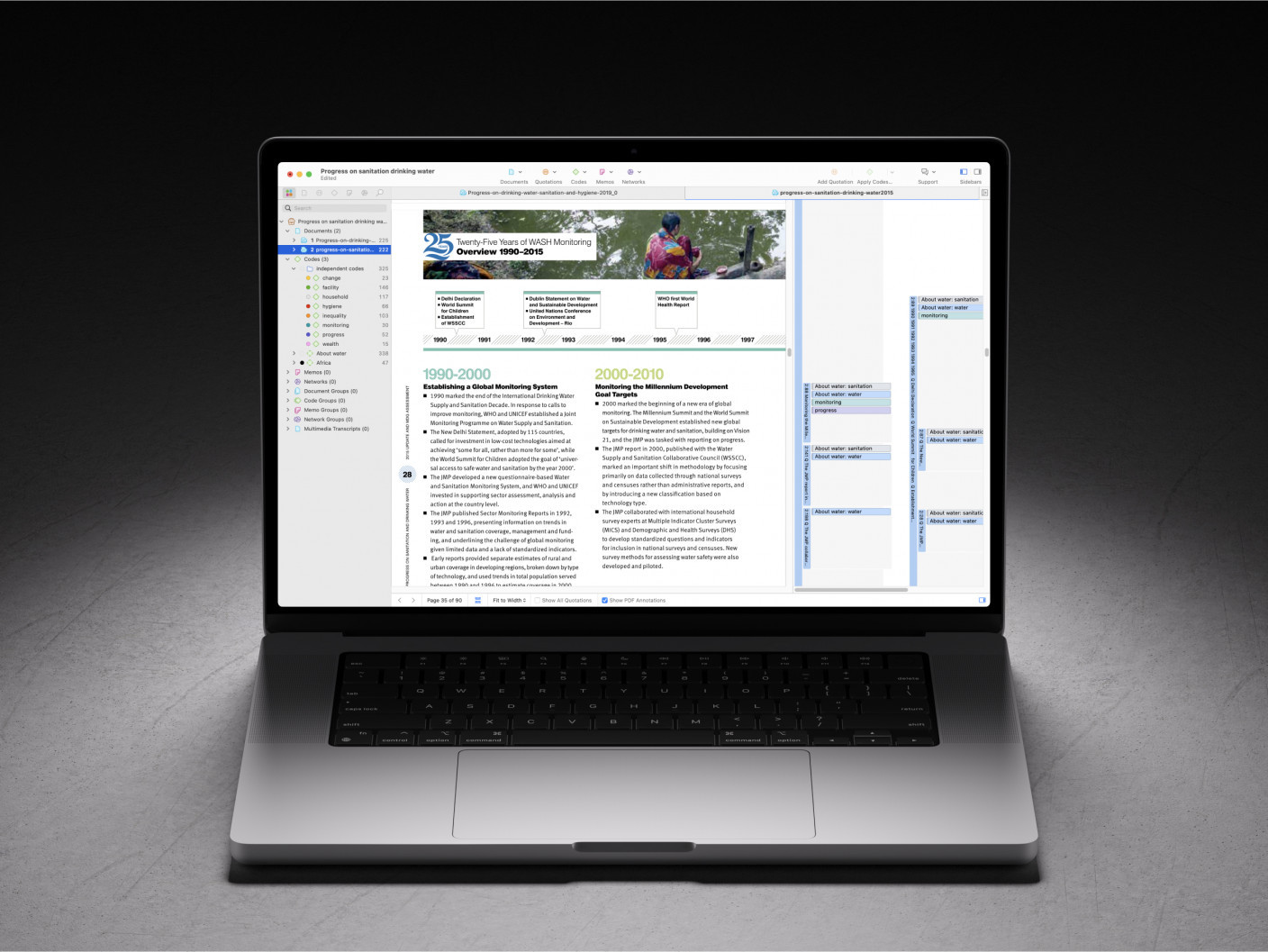Verbessern Sie Ihre Analysen mit KI-gestützten Tools
- Wie können KI-Tools bei der qualitativen Datenanalyse helfen?
- Verstehen Sie genau, was gesagt wird mit Word Cloud
- Finden Sie alle relevanten Daten mit der Textsuche
- Erkennen Sie alle Personen, Orte und Organisationen mit Named Entity Recognition
- Erfassen Sie die Reaktionen und Emotionen der Menschen mit Sentiment Analysis
- Entdecken Sie Themen, Themen oder Verbindungen mit der Konzeptsuche
- Vertiefen Sie Ihre Erkenntnisse mit Opinion Mining
- Erschließen Sie innovative Erkenntnisse mit anderen Analysetools
- Wie man „Beleben Sie Ihre Analysen mit KI-gestützten Tools“ zitiert
Wie können KI-Tools bei der qualitativen Datenanalyse helfen?
Qualitative Forschung birgt ein großes Potenzial, innovative Erkenntnisse freizusetzen, da die Daten in einer offenen Art und Weise erhoben werden, die es den Menschen erlaubt, sich auszudrücken und über alles zu sprechen, was sie für relevant halten. Doch die Sache hat einen Haken: Die Analyse qualitativer Daten kann sehr zeitaufwändig sein! Das liegt ganz einfach daran, dass so viele Informationen vorhanden sind - sowohl in Form von expliziten, oberflächlichen Details als auch in Form von subtilen Nuancen, die hinter dem Gesagten liegen. Lange Zeit war es äußerst schwierig, digitale Technologien zu entwickeln, mit denen sich die Analyse umfangreicher Daten wie Interviews, Fokusgruppen, Umfragen, Kommentare und anderer Textarten effektiv automatisieren ließ. Doch diese Zeiten liegen nun hinter uns, da sich die Technologie in exponentiellem Tempo weiterentwickelt!
Programmierer und Softwareentwickler haben Technologien der künstlichen Intelligenz (KI) entwickelt, die die Verarbeitung natürlicher Sprache (NLP) einbeziehen, und Forscher können endlich KI-gesteuerte Tools nutzen, um ihre qualitative Datenanalyse zu erleichtern. Das ATLAS.ti AI Lab hat lange und hart daran gearbeitet, NLP-Features zu entwickeln, die den Bedürfnissen der Forscher entsprechen, und ATLAS.ti bietet nun eine breite Palette von Tools, die neue Potenziale für jede Methodik und jede Forschungsfrage erschließen können.
Verstehen Sie genau, was gesagt wird mit Word Cloud
Das Wesentliche bei der Auswertung von qualitativen Daten ist die Analyse von Wörtern: Worüber haben die Teilnehmer gesprochen? Was geht in einem bestimmten Text vor sich? In dem Moment, in dem Sie die Daten in den Händen halten, können Sie mit der Word Cloud in ATLAS.ti Desktop bereits damit beginnen, potenzielle Muster aufzudecken und zu erforschen.
Sie haben z.B. gerade Umfragedaten gesammelt, in denen die Teilnehmer gebeten wurden, ein Videospiel wie z.B. Minecraft zu bewerten. Noch bevor Sie die Antworten der Befragten öffnen und lesen, können Sie in einer Word Cloud sehen, was genau gesagt wurde, die alle im Text vorkommenden Wörter und deren Häufigkeit anzeigt. Verwenden Sie Stopplisten, Go-Listen und setzen Sie Schwellenwerte, um sich auf das Wesentliche zu konzentrieren. Anhand der Minecraft-Umfragedaten können Sie bereits erkennen, dass die Teilnehmer vor allem über Gefühle, Gedanken und Menschen sprachen und das Wort "toll" sehr häufig vorkam. ATLAS.ti macht es noch einfacher zu verstehen, welche Wörter erwähnt wurden, indem es Grundformen ableitet oder automatisch alle Variationen desselben Wortes kombiniert (z.B. "play", "played" und "playing"). Wenn Sie wirklich genau wissen wollen, was gesagt wird, können Sie ATLAS.ti die Ergebnisse nach bestimmten Wortarten filtern lassen. So könnten Sie sich beispielsweise nur auf die Adjektive in den Daten konzentrieren, um zu sehen, wie die Befragten das Spiel beschrieben haben. Es ist nicht nur interessant zu sehen, was jeder gesagt hat, sondern auch, verschiedene Gruppen von Befragten zu vergleichen (z.B. diejenigen, die das Spiel spielen und diejenigen, die es nicht spielen). Die Word Cloud in ATLAS.ti kann zur Suche in jedem Teil Ihres Projekts verwendet werden: Dokumente, Zitate, Kodes und Gruppen. Sie können Ihre Ergebnisse auch weitergeben, indem Sie Wortlisten und Word Clouds exportieren und es anderen erleichtern, genau zu verstehen, was in Ihren Daten gesagt wird.

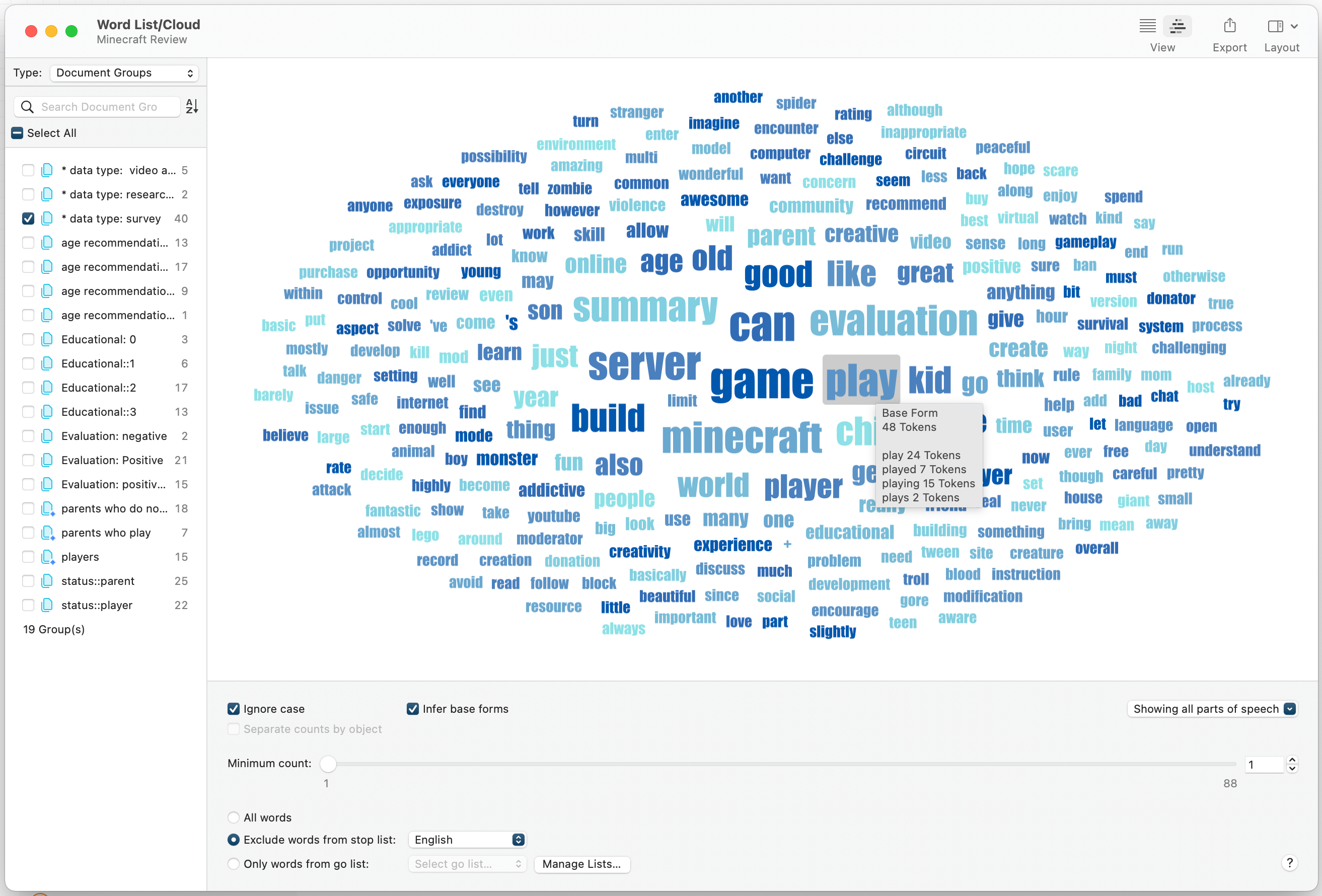
Finden Sie alle relevanten Daten mit der Textsuche
Wenn Sie wissen wollen, was über ein bestimmtes Wort oder Thema gesagt wird, wollen Sie nicht erst den gesamten Text durchforsten und dabei riskieren, einige relevante Stellen zu übersehen! ATLAS.ti's Text Search geht für Sie durch den Text und zeigt Ihnen alle Daten zu Ihrem Suchbegriff an - zusammen mit allen Synonymen und flektierten Formen - und Sie können die Ergebnisse sofort mit Codes (oder Tags) versehen, um Ihre Ergebnisse zu speichern und Ihre wertvolle Zeit zu sparen.
Wenn Sie zum Beispiel analysieren möchten, was die Befragten über das Videospiel Minecraft gesagt haben, möchten Sie vielleicht verstehen, was sie über das Bauen von Dingen gesagt haben, da dies ein zentrales Merkmal des Spiels ist. Mit einer einfachen Textsuche würde man jedoch die Fälle übersehen, in denen die Befragten über das Konstruieren, Herstellen oder Zusammensetzen von Dingen sprachen. Die in ATLAS.ti's Textsuche integrierte Smart Search findet alle relevanten Daten für Sie und bezieht auch Synonyme und flektierte Formen mit ein, so dass Sie sich keine Sorgen machen müssen, etwas zu übersehen. Sie sehen alle Ergebnisse sofort in einer Liste und können sie leicht mit Codes versehen. Unabhängig davon, wie viel Text Sie haben oder nach welchen Wörtern oder Phrasen Sie suchen, die Textsuche kann sofort die Ergebnisse erfassen, die für Sie von Interesse sind.
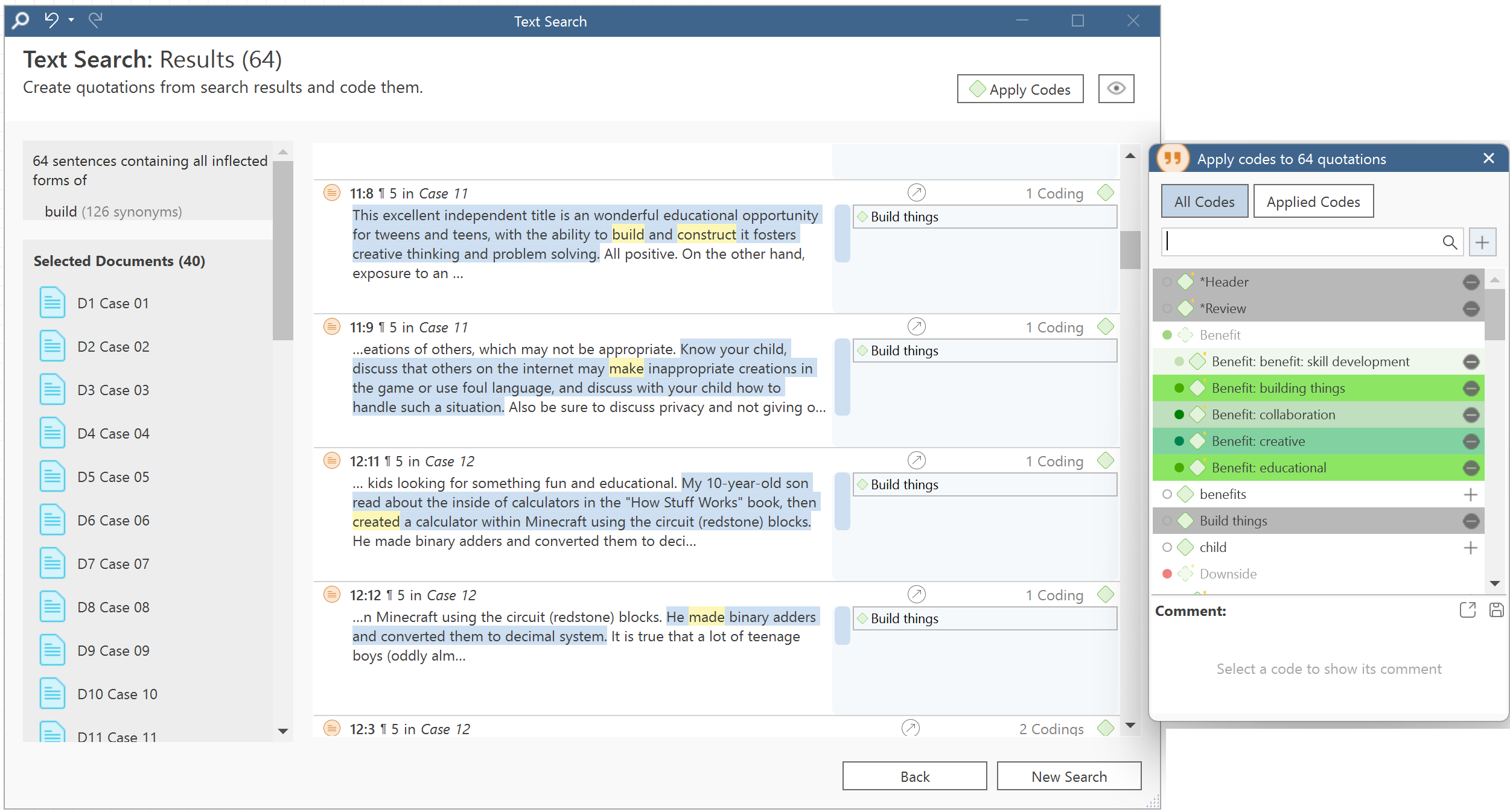

Erkennen Sie alle Personen, Orte und Organisationen mit Named Entity Recognition
Was, wenn Sie genau herausfinden wollen, worüber die Leute sprechen? Wahrscheinlich gibt es bestimmte Personen, Orte oder Organisationen, die in Ihren Daten auftauchen, aber Sie können unmöglich eine vollständige Liste erstellen, um sie selbst zu suchen und zu finden. Mit ATLAS.ti's Named Entity Recognition kann die natürliche Sprachverarbeitung sofort alle Personen, Orte, Organisationen und andere Entitäten (wie z.B. Kunstwerke, Sprachen, politische Parteien und mehr) identifizieren und verschlüsseln.
Sie können zum Beispiel eine bestimmte Entität analysieren, wie das Videospiel Minecraft, aber es ist auch wichtig zu verstehen, wie die Teilnehmer diese mit anderen ähnlichen Entitäten vergleichen. Darüber hinaus haben viele Videospiele große Online-Communities und können auf verschiedenen Plattformen gespielt werden, und wenn Sie untersuchen, wo diese Communities interagieren und spielen, können Sie tiefere Einblicke gewinnen. Mit Named Entity Recognition lässt sich leicht erkennen, über welche Konsolen die Teilnehmer sprachen, z.B. Nintendo und Xbox, und wie die Spieler YouTube nutzten, um zu lernen und Inhalte zu teilen. ATLAS.ti unterstützt Ihre Analyse zusätzlich, indem es automatisch Codes für jede Entität vorschlägt, die mit einem Klick allen relevanten Daten zugeordnet werden können.
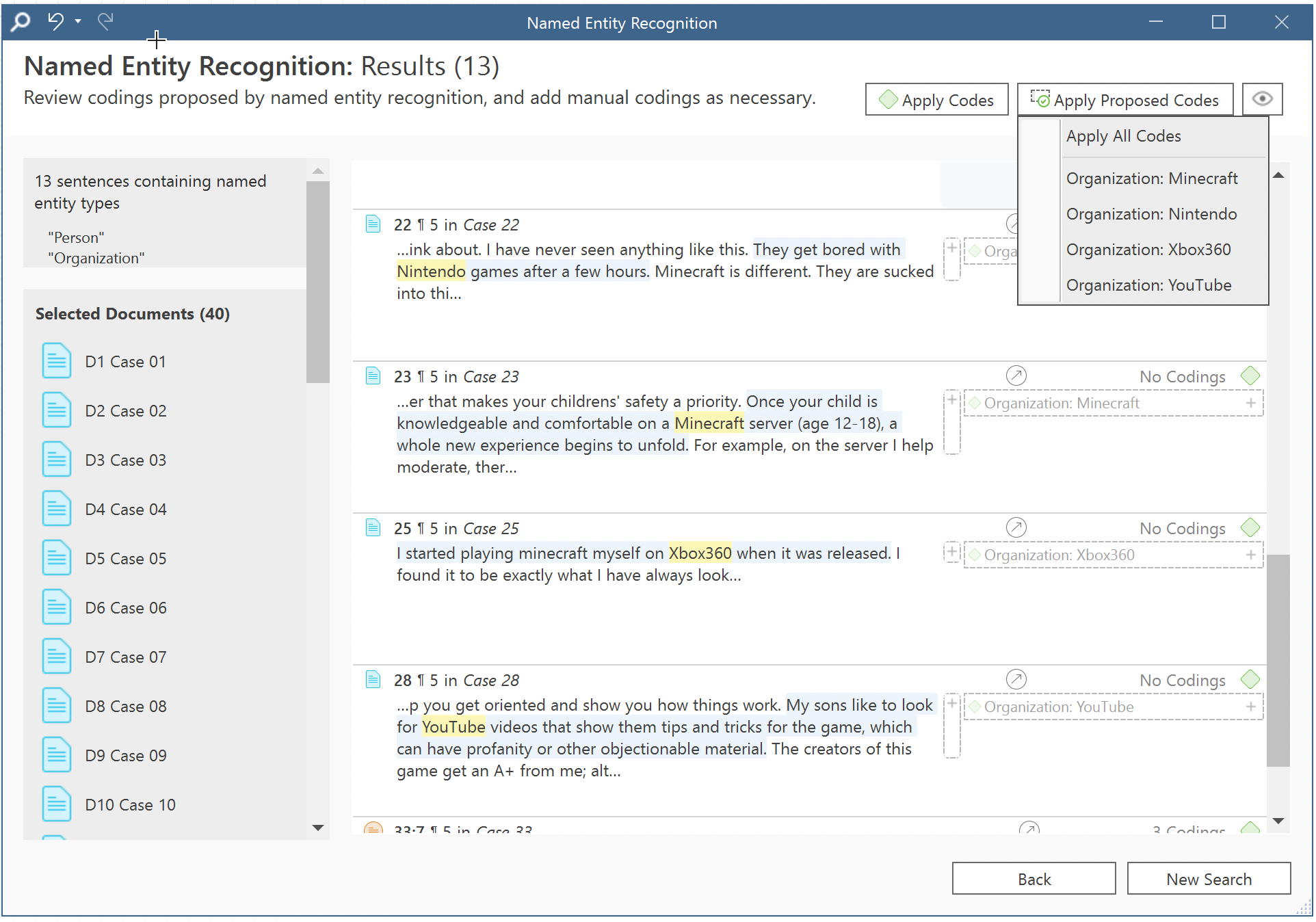

Erfassen Sie die Reaktionen und Emotionen der Menschen mit Sentiment Analysis
Zu verstehen, wie Menschen über etwas denken, ist oft ein wichtiger Teil der Analyse. Wenn Teilnehmer die Möglichkeit haben, sich in ihren eigenen Worten auszudrücken, kann der Tonfall, in dem sie sprechen, eine Menge über die Person und tiefere oder subtilere Muster verraten. ATLAS.ti's Sentiment Analysis nutzt die fortschrittliche Verarbeitung natürlicher Sprache, um automatisch alle positiven, neutralen und negativen Stimmungen in Ihren Daten zu identifizieren und zu kodieren.
Sobald Sie zum Beispiel die Antworten auf Ihre Umfrage erhalten haben, möchten Sie vielleicht untersuchen, was die einzelnen Personen über das von Ihnen untersuchte Thema denken. Sentiment Analysis macht es Ihnen leicht, den Reaktionen und Gefühlen auf den Grund zu gehen: Sie sehen alle Ergebnisse in einer Liste und können die Befunde sofort mit den von ATLAS.ti vorgeschlagenen Codes für jedes Gefühl kodieren. Mit einem Klick können Sie alle Gefühle in Ihren Daten kodieren lassen und so herausfinden, welche Gefühle bei den Teilnehmern vorherrschend waren, verschiedene Gruppen von Teilnehmern vergleichen und vieles mehr.
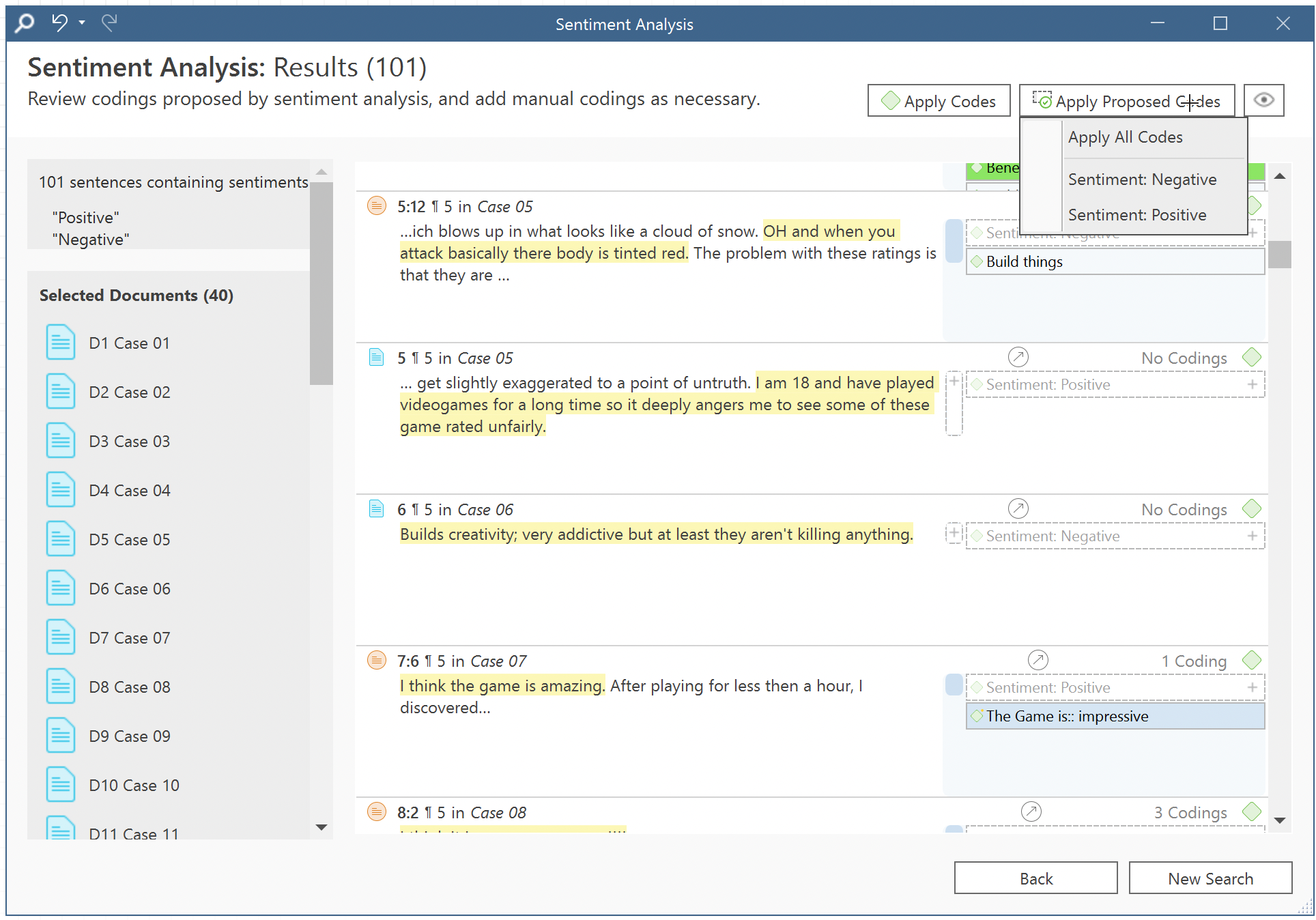

Entdecken Sie Themen, Themen oder Verbindungen mit der Konzeptsuche
Zu verstehen, worüber gesprochen wird, scheint eine einfache Aufgabe zu sein, aber sie kann schnell sehr komplex werden, wenn viele Nuancen auftauchen und mehrere Wege zur Kategorisierung der Ergebnisse plausibel erscheinen. Die Identifizierung und Synthese der Hauptthemen in den Daten ist von zentraler Bedeutung, um Zusammenhänge und Muster zu erkennen, die zu innovativen Erkenntnissen führen können. ATLAS.ti's Concept Search findet die meistgenannten Substantive zusammen mit den dazugehörigen Wörtern in jedem beliebigen Text, so dass Sie potentielle Themen, Themen oder Verbindungen in Ihren Daten sofort kodieren und untersuchen können.
Vielleicht haben Sie zum Beispiel verschiedene Artikel, Berichte oder Webseiten gesammelt, die Sie lesen möchten, um mehr über Ihr Thema zu erfahren. Vielleicht untersuchen Sie, wie Kinder und Jugendliche durch Videospiele wie Minecraft lernen können, und Sie wissen, dass es viele verschiedene Arten des Lernens gibt. Anstatt Zeit damit zu verbringen, die gesamte einschlägige Literatur zu durchsuchen, um die verschiedenen Lernansätze zu ermitteln, die Sie untersuchen könnten, können Sie eine Konzeptsuche durchführen und sofort sehen, welche Konzepte und Unterkonzepte in Ihrem gesamten Text behandelt werden, z. B. spielbasiertes Lernen, gemeinsames Lernen und kreatives Lernen. Sie können die Hauptkonzepte einfach als Word Cloud oder Wortliste anzeigen lassen und dann auf ein beliebiges Konzept klicken, um alle Unterkonzepte und die genauen Textabschnitte zu sehen. Auf diese Weise können Sie sich sofort mit den Informationen in Ihrem Text auseinandersetzen und tiefere Einblicke gewinnen, da Sie übergreifende Muster leicht erkennen und heranzoomen können, um genau zu untersuchen, wie diese Muster ausgedrückt und miteinander verwoben werden. Mit einem Klick können Sie die von ATLAS.ti vorgeschlagenen Kodes mit den Konzepten oder Unterkonzepten Ihrer Wahl verknüpfen, so dass Sie sofort nach Details kodieren und sich auf Muster konzentrieren können, die Licht auf die Fragen werfen, die Sie interessieren.
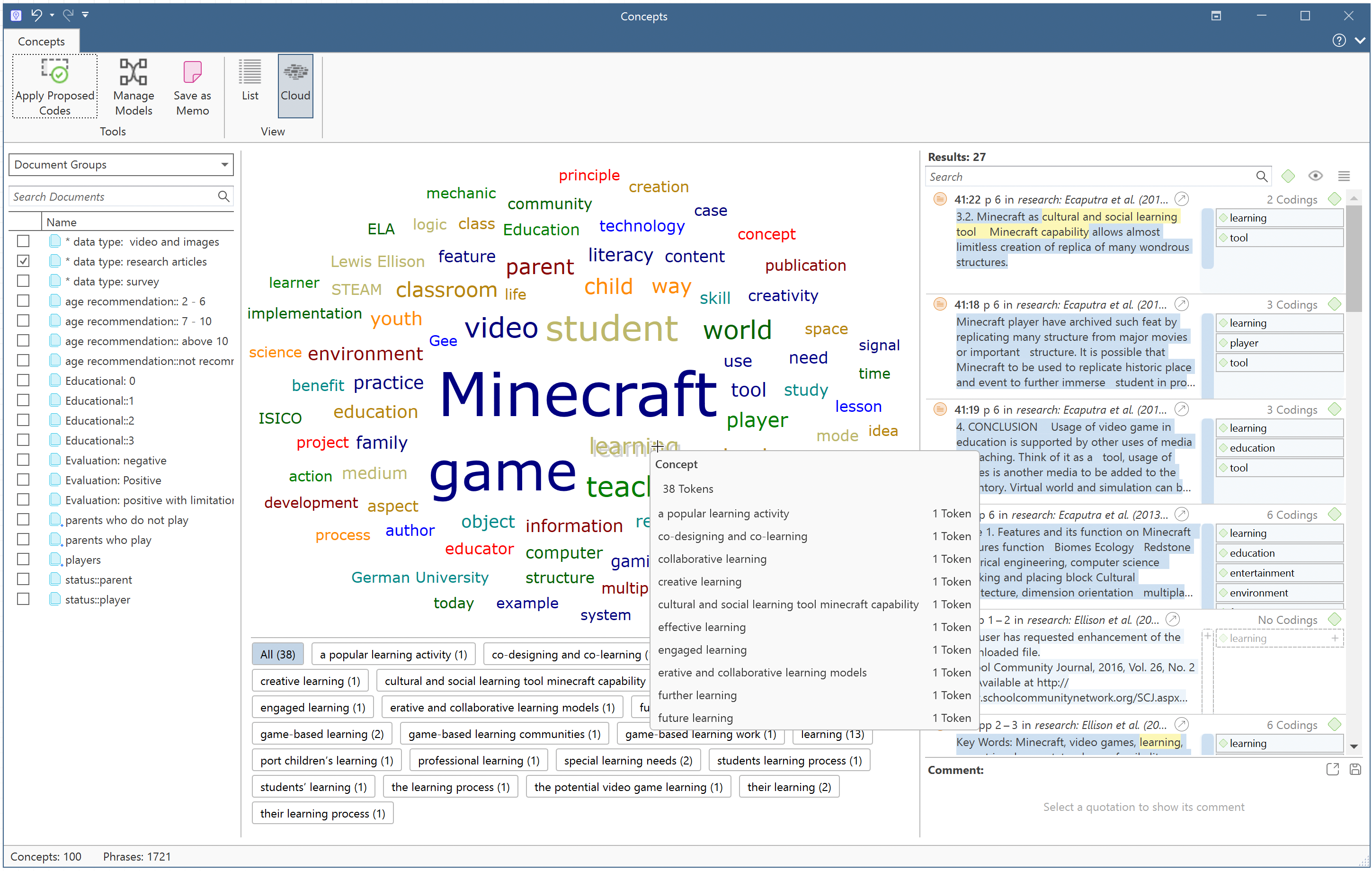
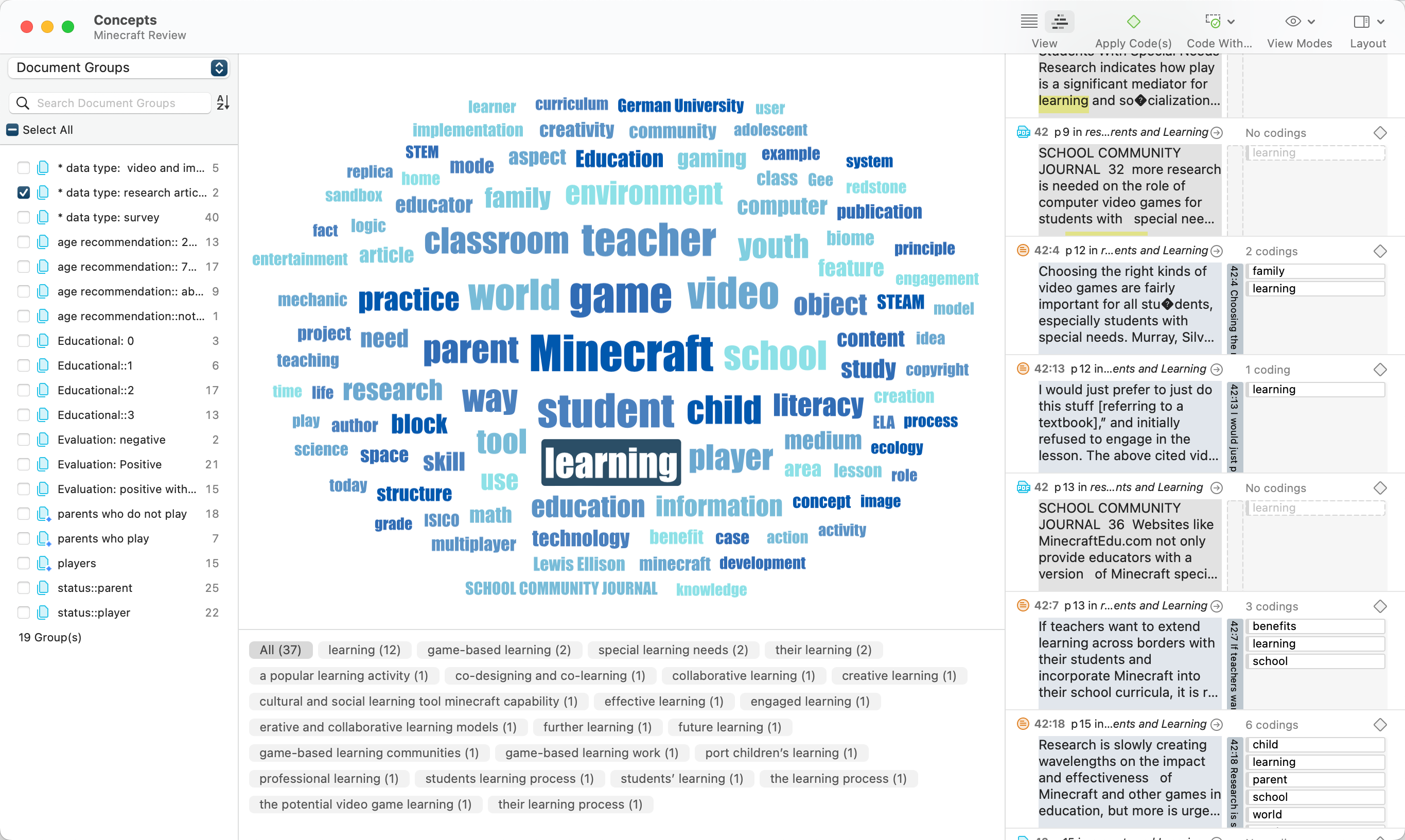
Vertiefen Sie Ihre Erkenntnisse mit Opinion Mining
Wenn Menschen offene Fragen gestellt werden, sind die Möglichkeiten, Meinungen zu verschiedenen Themen zu äußern, praktisch endlos. Es ist sicherlich wichtig zu verstehen, worüber die Menschen sprechen, aber ebenso wertvoll ist es, zu erfassen, wie die Menschen über diese verschiedenen Dinge denken: Mögen sie es oder mögen sie es nicht? Stimmen sie zu oder widersprechen sie? Erforschen Sie die Meinungen in Ihren Daten und gewinnen Sie tiefere Einblicke.
Sobald Sie z.B. Antworten auf Ihre Umfrage erhalten haben, werden Sie wahrscheinlich daran interessiert sein, zu sehen, welche Meinungen geäußert wurden. Mit ATLAS.ti's Opinion Mining sehen Sie sofort, worüber gesprochen wird und ob ein Thema oder Konzept positiv oder negativ gesehen wird. Farbige Balkendiagramme machen es leicht, die Meinungen in Ihren Daten zu verstehen, und Sie können per Mausklick die Daten hinter jeder Meinung einsehen. Wenn Sie analysieren, was Eltern über das Videospiel Minecraft sagen, können Sie sofort sehen, was ihnen an dem Spiel gefällt oder nicht gefällt. Die von ATLAS.ti vorgeschlagenen Codes werden automatisch angehängt, um Ihre Ergebnisse zu speichern, so dass Sie sich ganz auf die Erstellung Ihrer Analyse konzentrieren können.
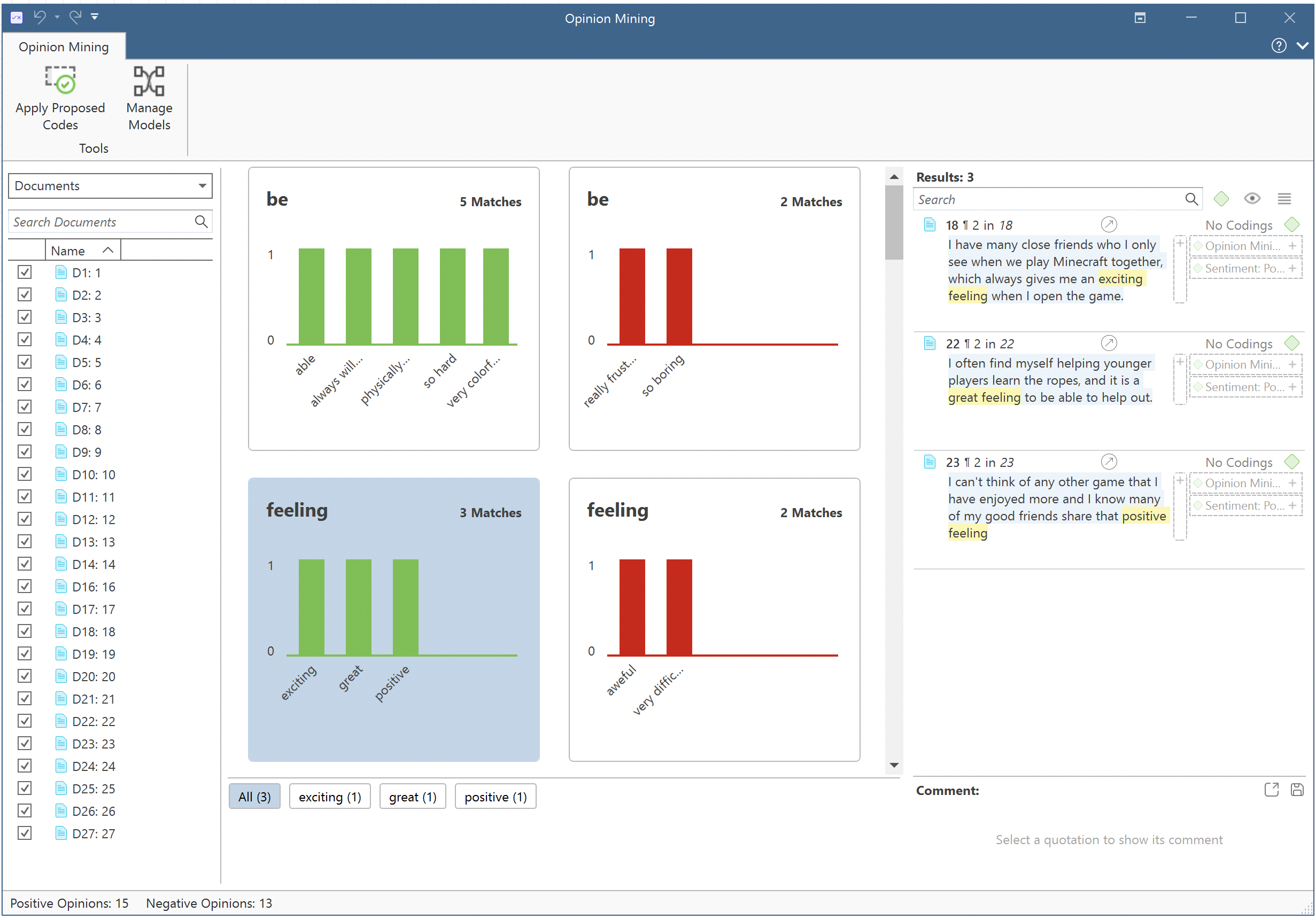
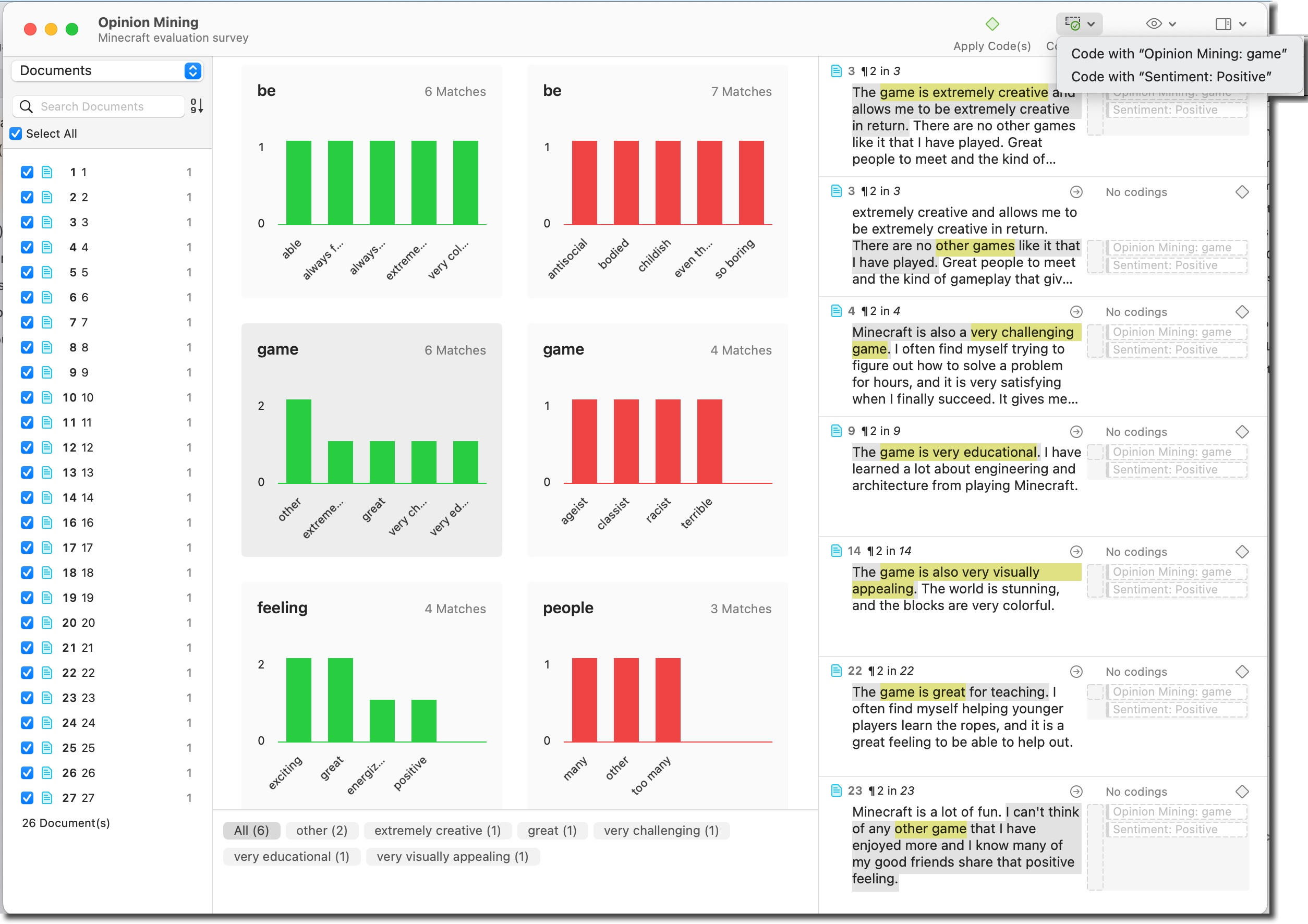
Erschließen Sie innovative Erkenntnisse mit anderen Analysetools
Das ATLAS.ti AI Lab hat leistungsstarke Tools entwickelt, die automatisch jeden zu analysierenden Text suchen, filtern und sogar codieren können. Das Anbringen von Codes an relevanten Datensegmenten ist oft der zeitaufwändigste Teil der Analyse qualitativer Daten, aber dank der Entwicklungen im Bereich der künstlichen Intelligenz und der Verarbeitung natürlicher Sprache können Sie Ihre Daten in Minuten statt in Tagen codieren.
Sobald Sie Ihre Daten kodiert haben, können Sie sie ganz einfach abfragen und mit ATLAS.ti's anderen Funktionen auf alle möglichen Arten tiefer graben. Sie können z.B. untersuchen, welche Gefühle in Bezug auf verschiedene Entitäten geäußert wurden, indem Sie die Kode Co-occurrence Table, oder die Meinungen verschiedener Gruppen von Teilnehmern mit Hilfe der Kode-Dokumenten-Tabelle. Exportieren Sie verschiedene Arten von Ergebnissen, wie z. B. Tabellen, Tabellenkalkulationen, Word Clouds, Netzwerke und Sankey-Diagramme, um Ihre Ergebnisse mit ansprechenden visuellen Darstellungen zu präsentieren, die Ihren Zuhörern Ihren Standpunkt effektiv vermitteln.
Diese KI-gesteuerten Werkzeuge erleichtern Ihnen die Analyse, indem sie Ihnen helfen, relevante Daten zu identifizieren und zu kodieren. Sie können sich auf die ATLAS. ti-Software, Lernressourcen, Beispielprojekte und das ATLAS. ti-Supportteam verlassen, die Ihnen helfen, aufkommende Muster zu erforschen und aussagekräftige Erkenntnisse zu entwickeln.
Wie man „Beleben Sie Ihre Analysen mit KI-gestützten Tools“ zitiert
APA (7. Auflage)
Kalpokas, N. (2020). Beleben Sie Ihre Analysen mit KI-gestützten Tools. ATLAS.ti Research Hub. Abgerufen von https://atlasti.com/research-hub/invigorate-your-analyses-with-ai-powered-tools
MLA (9. Auflage)
Kalpokas, Neringa. „Beleben Sie Ihre Analysen mit KI-gestützten Tools.“ ATLAS.ti Research Hub, 2020, https://atlasti.com/research-hub/invigorate-your-analyses-with-ai-powered-tools.
Chicago (17. Auflage)
Kalpokas, Neringa. „Beleben Sie Ihre Analysen mit KI-gestützten Tools.“ ATLAS.ti Research Hub. 2020. https://atlasti.com/research-hub/invigorate-your-analyses-with-ai-powered-tools.


